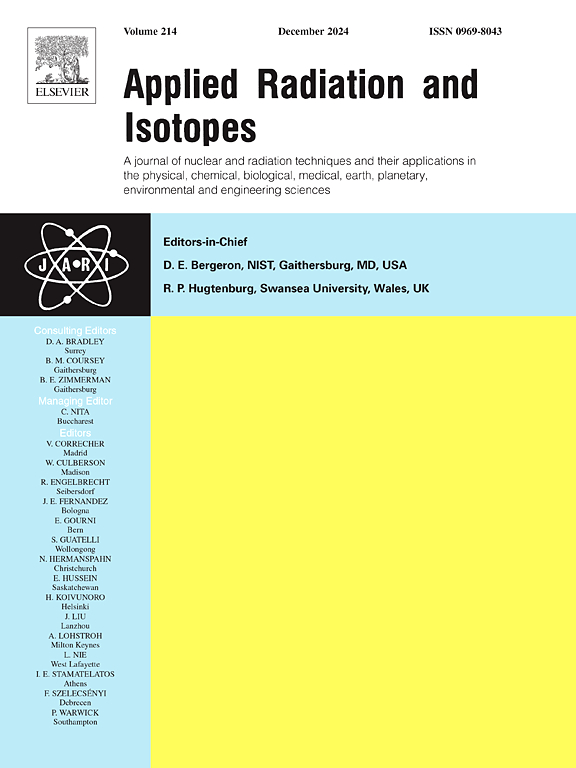Validation of a general-use high flux isotope reactor–specific metaheuristic optimization framework for isotope production target design
IF 1.6
3区 工程技术
Q3 CHEMISTRY, INORGANIC & NUCLEAR
引用次数: 0
Abstract
Currently, advanced optimization methods are limited for isotope production (IP) campaigns at the US Department of Energy’s High Flux Isotope Reactor (HFIR) located at Oak Ridge National Laboratory (ORNL), leading to years of conservative and historical approaches with minimal innovation. Moreover, the growing demand for new and existing isotopes is beginning to challenge the capacity of HFIR. This work explores the development and integration of metaheuristic (MH) optimization techniques for more efficient target design and irradiation strategies. As a test case, the optimization framework was applied to a routinely produced isotope at HFIR, 188W, with the objective of maximizing the specific activity (SA), a key production metric. The framework includes Gnowee, a Python-based MH optimization algorithm, coupled with the Monte Carlo N-Particle version 6 (MCNP6) and Oak Ridge Isotope Generation (ORIGEN) activation/depletion/decay codes to design, simulate, and evaluate thousands of potential target design and irradiation scheme candidates. The framework relies on mock input files, design and irradiation variables for the algorithm to select, as well as a user-defined objective function to score each candidate based on the returned SA. Given the inherent complexities and computational time required when modeling and simulating the full HFIR model, a novel simplified MCNP6 model is presented in this article to increase the computational efficiency of the framework. The variables explored include irradiation location, number of cycles, and the number of W samples. Over 1,000 simplified model candidates were simulated in the same amount of time as a single full HFIR model run. By comparing the simplified model optimization’s top candidate(s) with the full HFIR model results, the framework was verified to accurately explore the design space and converge on the top performing candidates. Lastly, past experimental data was compared to the data generated by the framework/model and both show that fewer W rings return higher SA, as expected. The verified and validated techniques provide a standardized solution to increase IP efficiencies by exploring thousands of unique target designs and irradiation strategies in a similar time as that required to run a single case in the full HFIR MCNP6 model. Both the novel simplified model and the full HFIR model show a more than 30% increase in SA if all presented modifications are applied to the current design and strategy. Thus, the objective of building a general-use, computationally efficient optimization framework for HFIR IP was accomplished, and has the potential to be applied to other IP campaigns.
验证用于同位素生产目标设计的通用高通量同位素反应堆特定元启发式优化框架
目前,美国能源部位于橡树岭国家实验室(ORNL)的高通量同位素反应堆(HFIR)的同位素生产(IP)活动中,先进的优化方法非常有限,导致多年来一直采用保守的历史方法,创新性极低。此外,对新同位素和现有同位素日益增长的需求也开始挑战高通量同位素反应堆的能力。这项工作探索了元启发式(MH)优化技术的开发和整合,以实现更高效的靶设计和辐照策略。作为一个测试案例,优化框架被应用于 HFIR 常规生产的同位素 188W,目标是最大化比活度(SA),这是一个关键的生产指标。该框架包括基于 Python 的 MH 优化算法 Gnowee,以及蒙特卡罗 N 粒子版本 6 (MCNP6) 和橡树岭同位素生成 (ORIGEN) 激活/耗竭/衰变代码,用于设计、模拟和评估数千个潜在的目标设计和辐照方案候选方案。该框架依赖模拟输入文件、设计和辐照变量供算法选择,以及用户定义的目标函数,根据返回的 SA 对每个候选方案进行评分。鉴于完整的 HFIR 模型建模和仿真所固有的复杂性和所需的计算时间,本文提出了一个新颖的简化 MCNP6 模型,以提高该框架的计算效率。所探讨的变量包括辐照位置、周期数和 W 样本数。在与运行一个完整的 HFIR 模型相同的时间内,模拟了 1,000 多个简化候选模型。通过比较简化模型优化的最佳候选模型和完整 HFIR 模型的结果,验证了该框架能够准确地探索设计空间,并收敛到性能最佳的候选模型上。最后,将过去的实验数据与该框架/模型生成的数据进行了比较,结果表明,正如预期的那样,较少的 W 环会产生较高的 SA 值。经过验证和确认的技术提供了一种标准化的解决方案,通过探索数千种独特的目标设计和辐照策略来提高 IP 效率,所需的时间与在完整的 HFIR MCNP6 模型中运行一个案例所需的时间相近。如果对当前的设计和策略进行所有的修改,新的简化模型和完整的 HFIR 模型都能将 SA 提高 30% 以上。因此,为 HFIR IP 建立一个通用、计算效率高的优化框架的目标已经实现,并有可能应用于其他 IP 活动。
本文章由计算机程序翻译,如有差异,请以英文原文为准。
求助全文
约1分钟内获得全文
求助全文
来源期刊

Applied Radiation and Isotopes
工程技术-核科学技术
CiteScore
3.00
自引率
12.50%
发文量
406
审稿时长
13.5 months
期刊介绍:
Applied Radiation and Isotopes provides a high quality medium for the publication of substantial, original and scientific and technological papers on the development and peaceful application of nuclear, radiation and radionuclide techniques in chemistry, physics, biochemistry, biology, medicine, security, engineering and in the earth, planetary and environmental sciences, all including dosimetry. Nuclear techniques are defined in the broadest sense and both experimental and theoretical papers are welcome. They include the development and use of α- and β-particles, X-rays and γ-rays, neutrons and other nuclear particles and radiations from all sources, including radionuclides, synchrotron sources, cyclotrons and reactors and from the natural environment.
The journal aims to publish papers with significance to an international audience, containing substantial novelty and scientific impact. The Editors reserve the rights to reject, with or without external review, papers that do not meet these criteria.
Papers dealing with radiation processing, i.e., where radiation is used to bring about a biological, chemical or physical change in a material, should be directed to our sister journal Radiation Physics and Chemistry.
 求助内容:
求助内容: 应助结果提醒方式:
应助结果提醒方式:


